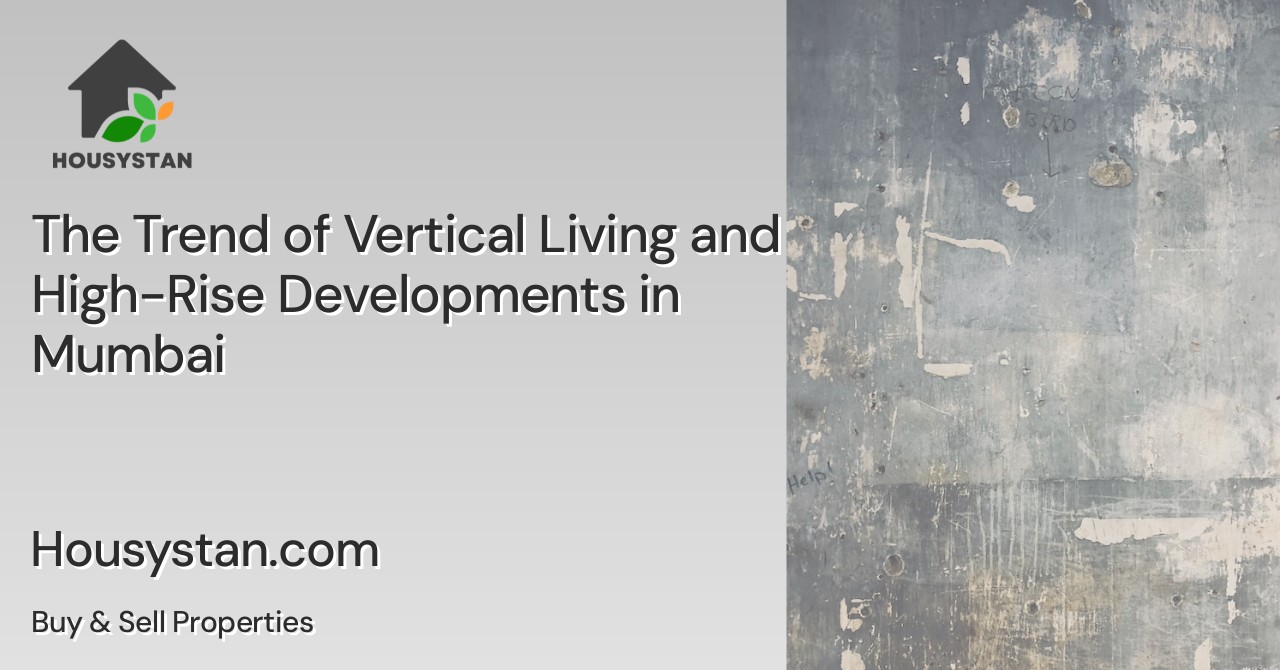The Trend of Vertical Living and High-Rise Developments in Mumbai
Read latest blogs and articles from Housystan

The Information mentioned here was last updated on:
2/12/2025The Trend of Vertical Living and High-Rise Developments in Mumbai
Mumbai, India's bustling financial capital, has long been a hub of cultural diversity and economic opportunity. Over recent years, this city of nearly 20 million people has been transforming its skyline with towering high-rise buildings. These skyscrapers are not just architectural marvels; they represent the growing trend of vertical living in Mumbai, driven by necessity, convenience, and luxury. In this article, we explore the rise of vertical living and high-rise developments in Mumbai, examining the factors fueling this trend and its impact on the city's landscape and residents.
The Rise of Vertical Living
- Verified Tenants/Buyers
- Unlimited Property Listing
- Zero subscription/charges fee
Understanding Vertical Living
Vertical living refers to residing in high-rise apartment complexes. These buildings often consist of multiple floors and provide various amenities to their residents. As urban areas become more crowded, vertical living offers a solution to the problem of limited land space by accommodating more people in less physical space.
Why Mumbai?
Mumbai's unique geographical constraints make it a prime candidate for vertical living solutions. Sandwiched between the Arabian Sea to the west and the sprawling hinterlands inland, the city has little room to expand horizontally. As a result, developers have looked skyward, constructing skyscrapers to meet the demands of the metropolis.
Drivers of High-Rise Developments
Urbanization and Population Growth
The rapid urbanization of Mumbai is a primary driver of its vertical living trend. The city attracts millions of migrants annually, drawn by job opportunities and the promise of a better lifestyle. As the population grows, so does the demand for housing, prompting developers to build upwards rather than outwards.
High Land Prices
Land in Mumbai is incredibly valuable, commanding some of the highest prices in the world. This economic pressure encourages developers to maximize land use efficiency by constructing taller buildings that can house more people or enterprises in smaller footprints.
Infrastructure Improvements
Infrastructure advancements have also played a significant role in the rise of high-rise developments. Improvements in construction technology, building materials, and safety features have made it feasible to construct skyscrapers that are both durable and secure. Additionally, better public transportation networks make living in vertical structures practical, as residents can easily commute around the city.
Benefits of Vertical Living
Efficient Use of Space
High-rises ensure optimal use of limited urban space. By stacking living spaces vertically, the city can provide more housing units per square meter of land. This efficiency is vital in a densely populated city like Mumbai.
Modern Amenities
Many of Mumbai’s high-rise buildings are equipped with state-of-the-art amenities that enhance residents' quality of life. These can include swimming pools, gyms, landscaped gardens, and various recreational facilities that might not be possible in standalone homes.
Stunning Views
Residing in a high-rise offers breathtaking views of the cityscape, the sprawling sea, or green expanses, depending on the building's location. Higher floors can provide a peaceful escape from the bustling urban life below.
Challenges and Considerations
Social and Economic Disparities
While high-rise living offers numerous benefits, it's important to acknowledge the economic disparities that accompany this trend. Luxury high-rises offer facilities that are often inaccessible to the city's lower-income population. Bridging this divide remains a social challenge for planners and developers.
Cultural Shifts
Traditional Mumbai living has typically revolved around community spaces and joint family structures. The shift to individualized high-rise apartments marks a cultural shift that impacts social interactions and traditional lifestyles.
Environmental Concerns
The construction and maintenance of high-rise buildings pose environmental challenges. Such developments often require significant energy consumption, and their impact on local ecosystems must be managed carefully. Sustainable building practices are crucial in minimizing this impact while still meeting urban housing needs.
Iconic High-Rises in Mumbai
The Imperial Towers
Standing as an emblem of luxury, The Imperial Towers were completed in 2010 and remain among the tallest buildings in India. These towers reflect Mumbai's aspiration for grandeur in high-rise living, offering ultra-luxury apartments with panoramic views of the city and the sea.
World One
World One is another remarkable skyscraper reaching great heights in Mumbai's skyline. Not only is it a residential structure, but its construction involved sustainable methods, showing how the city can embrace eco-friendly practices in high-rise developments.
Lodha Bellissimo
This residential development is known for its innovative design and exceptional amenities. Reflecting modern architecture, Lodha Bellissimo caters to elite residents seeking premium lifestyle choices in the heart of Mumbai.
The Future of Vertical Living
Growth Prospects
The trend of vertical living in Mumbai is set to continue as the city's population grows and urban space becomes more precious. Future high-rise buildings will likely incorporate advanced technologies and sustainable practices, with a focus on energy efficiency and waste management systems.
Technological Innovations
Innovation in construction technologies, such as prefabrication and modular methods, is expected to reduce construction time and costs, further encouraging the development of high-rises. Smart home technology will also become increasingly significant, offering residents enhanced control and connectivity within their living spaces.
Government Policies and Initiatives
Achieving a balance between growth and sustainability in Mumbai requires supportive government policies. Initiatives to incentivize the construction of affordable housing within high-rise complexes could ensure greater inclusivity in vertical living.
As Mumbai continues to evolve, high-rises will remain a prominent feature of its skyline, addressing both the housing needs and aspirations of its diverse population. Their impact will shape the future of urban living, transforming the way Mumbaikars experience the metropolis.